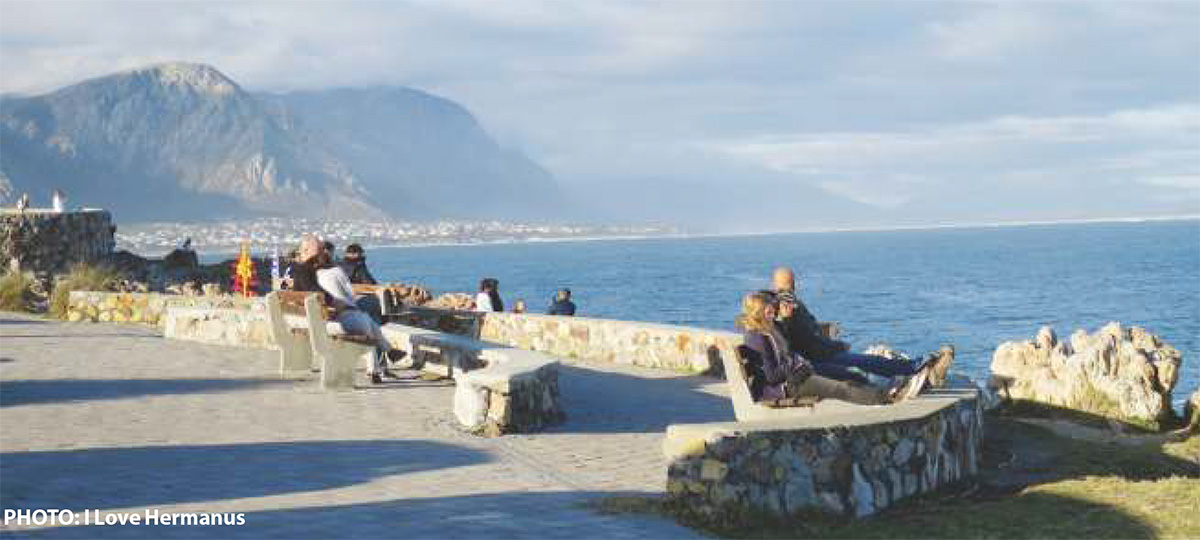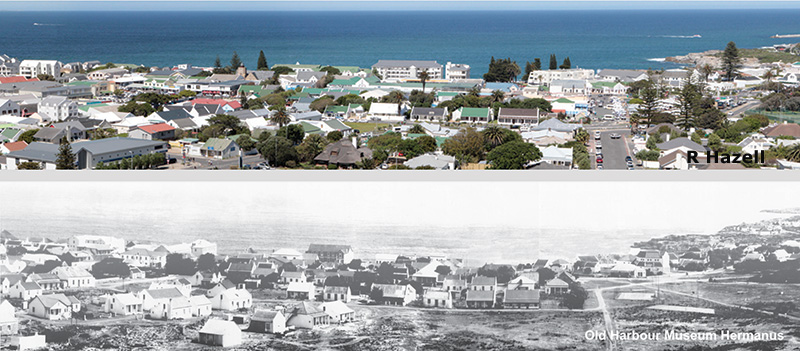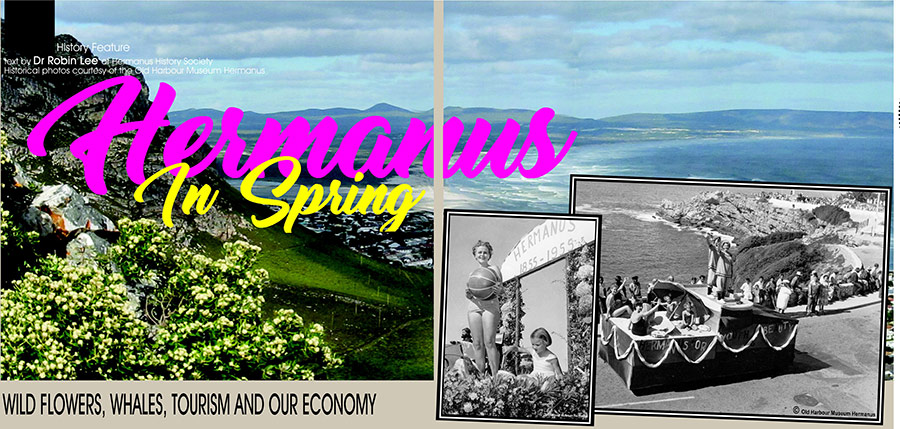
Searching for the Gearing of Gearing’s Point
September 4, 2017
Aberdeen Street in history – 1870 to 2017
September 28, 2017From the earliest accounts of Hermanus life, writers have never failed to praise life here in the spring. Fishing boats returned with larger catches in calmer seas. ‘Fountains’ flowed more freely after the winter rains. The ‘wild flowers’ bloomed in annual profusion, and the economy picked up after the winter, as guests of the hotels and other free-spending travellers returned to the town. In the 1930s, Joey van Rhyn Luyt, then co-owner of the Marine Hotel, describes the average spring in these words:
The coastline was not overgrown with bushes, as it is today (1970s), but covered in green turf, starred with daisies in the spring, and along the cliffs grew arums. The countryside bloomed with wild flowers and bushes of proteas (mainly the Bot River Protea and the sugar -bush), and heath covered the lower slopes of the mountains at De Mond. We used to gather armfuls of pypies, Afrikaners, watsonias, and a type of wild gladioli that we called ‘flames’. There were viooltjies, moederkappies, bluebells, and every kind of heath, chincherinchees, nerinas and everlastings. (From ‘In Those Days’, by Joey van Rhyn Luyt)
But one change that they could not have seen during spring, but we can, was the presence of whales in Walker Bay. By the 1920s whales had been hunted almost to extermination all around the world. According to many accounts, the same whale came alone every year to Walker Bay. The appearance was so unusual that they gave her a name: ‘Wendy”. She was one of the ‘local’ species of whale, the Southern Right whale, so called because it lives in the southern hemisphere and because, once dead, the body floats and is easier to secure than other whales, thereby making it the ‘right’ whale to kill.
Fortunately, what we call ‘the Cape Whale Coast’ never made a major impact on the numbers of whales killed. A small whaling station was established in Betty’s Bay in 1912 and operated sporadically until 1928. At the height of activity it employed 220 people and seems (records are scarce) to have caught 300 whales. Whaling boats operating out of Gansbaai also did not kill a large number of whales.
These numbers are negligible compared to the approximately 3 million whales killed around the world in the 19th and early 20th centuries. South Africa was one of the first countries to agree to the international ban on whale hunting in 1976. Since then the numbers of Southern Right whales along our coast have increased to more than 4000, but these are still few compared to the estimated 100 000 that once swam along our shores.
But, ‘Spring’ means different things to hotel managers than to tourists as the Luyts knew in late July 1944, when Berdine Luyt wrote this about that particular spring, as Allied troops slowly fought their way across Europe towards Nazi Germany:
About three days ago I was seized with a spring-cleaning mania. This is a slight form of insanity which attacks us periodically… There is only one cure: lots of cloths, brushes and brooms, a nice big apron and something to clean. The mania leaves us as suddenly as it comes, and, greatly refreshed, we are taken back into the family circle once more…I am writing this outside in the sun. It’s a heavenly day and we have all vacated the offices (it being very quiet) for the lawns outside the hotel. Mother is sewing and I am sitting on the grass with my portable typewriter balanced somewhat precariously on my knees, the paper flapping in the slight breeze. Connie [Berdine’s younger sister] is lying on her stomach next to me reading a “Superman” comic (one of her weaknesses), and there are a few visitors in deckchairs under the sun umbrellas. (‘Luyt’s Marine’ by Berdine Luyt)
Since the early 1990s Hermanus has benefitted greatly from the ban on whaling and the consequent inflow of tourists eager to see whales in “the town with the best land-based whale watching in the world”. The words ‘whale’ and ‘whale coast’ and other variations of them are now applied to festivals of various kinds, to cycling and other physical endurance competitions, to various types of wine and in many other ways. In an interesting variation of the theme, the premier Afrikaans literary festival has focused on the fact that the female whales come here to calve and has taken the name ‘Kalfiefees’ – the small calf festival. It has prospered under that title.
BUT – historians can never resist a ‘but’- the past has a huge lesson for us. The bounty brought by the whales will exist only as long as the whales continue to come to Walker Bay. We have a poor record as regards conservation of our natural assets. In the 1920s and 1930s Hermanus enjoyed an economic boom based on commercial fishing and tourist angling. BUT we went too far. Trawlers were allowed in the Bay (one weekend in the 1970s the Hermanus News reported counting 73 foreign trawlers working here) and as a result of modern fishing methods the Bay soon had no fish at all. Anglers went elsewhere and local fishermen had to seek other sources of income.
Then, we did it again: in the 1950s Hermanus experienced an abalone boom, with dozens of divers operating from the recently-opened New Harbour and the local canning factory exporting around 650 000 canned perlemoen a year. Now perlemoen have to be cultivated outside of the sea. Only poachers can find them in the ocean.
The fynbos biome in and around Hermanus has been preserved mainly by private bodies. Although the premier resource, Fernkloof Nature Reserve, is a municipal reserve, it barely features in the municipal budget and I understand that some paths are at present impassable after recent rains. If whales are frightened away by boat noise, if perlemoen poaching continues to flourish and if fewer tourists come to us but find that they cannot walk among the ‘wild flowers’ so beloved of previous generations of Hermanus citizens, we could well have squandered three more of the ‘gifts of spring’ that make our town unique. And if we allow them to disappear (like our forefathers made sure the fish and the abalone did), the tourists will be gone and with them the economy of Hermanus.
By Dr. Robin Lee
Date: August/September 2017
Image- Courtesy Whale Talk

